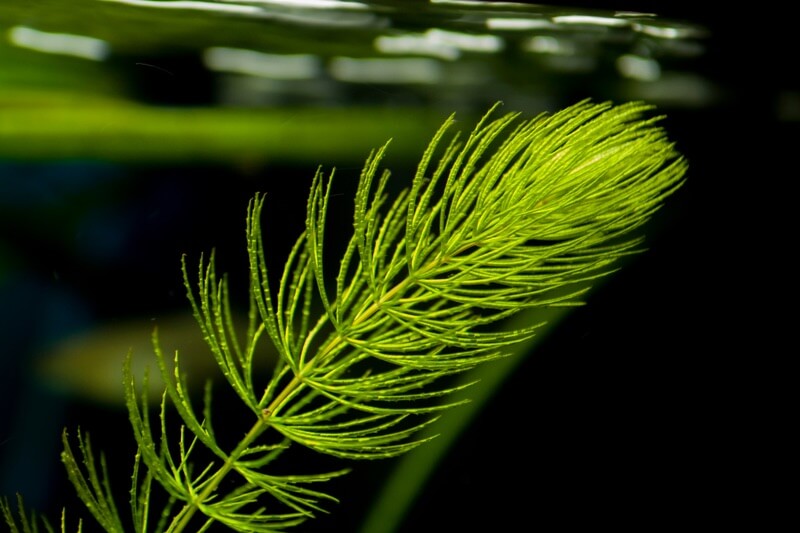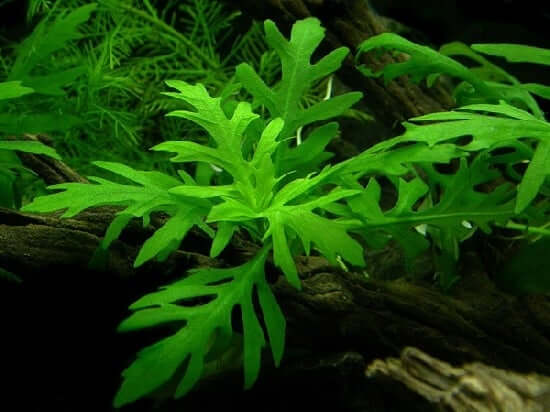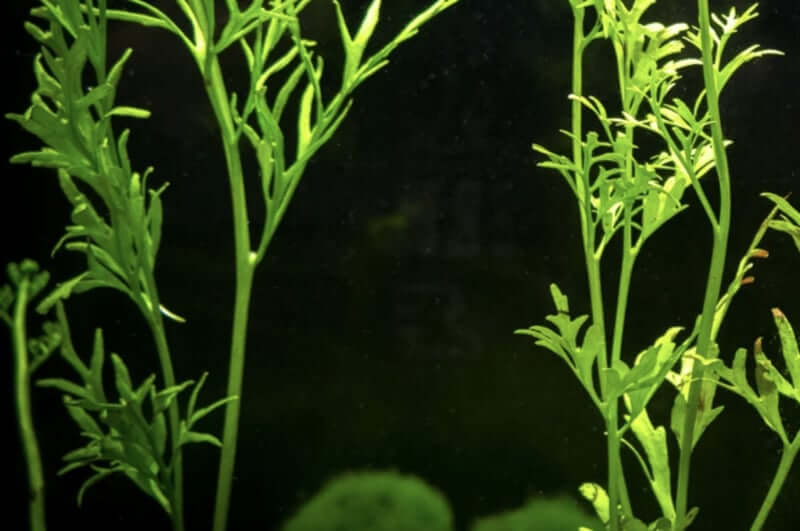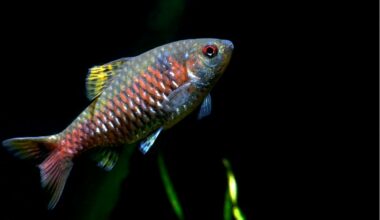Floating aquarium plants can bring a completely new dynamic to your tank. In fact, they’re our favorite suggestion for aquarists who want to improve the overall aesthetic of their environment.
When you see them in action the reason is clear.
The best floating aquarium plants give your tank a natural and wild feel that can’t come from anything else. There’s something about the light and colors they cast that change your whole perspective.
You go from viewing your fish in your tank to an observer of a natural habitat. It really feels like you jumped underwater somewhere halfway around the world!
In this guide, we’ll go over everything you need to know about the best floating plants for your fish tank. This list will give you all the options you need to take your aquarium to the next level!
Table of Contents
Advantages & Benefits (Aside From Visual Appeal)
Aside from the aesthetic appeal these plants bring, there are other advantages to adding floating plants to your aquarium. It’s worth taking a second to point these out before going into our list so you can decide which plant is right for you.
Shade
Since these plants float along the surface they influence the amount of light that enters the water.
If you have a species of fish that’s used to shady waters, a floating plant can make them feel right at home. Not only will this keep them comfortably physically, but it will also reduce their stress levels as well.
It’s important to be aware of how much light the critters in your tank need to thrive. Some of them might like it shady, while others prefer well-lit waters. Take this into account when deciding just how much of the surface you want your floating plant to take up.
The Magic Of Plants
Just like any plant, floating aquarium plants bring a wide range of benefits to the water. These benefits will make your job easier as a fishkeeper and also provide a more comfortable habitat for your fish.
Plants operate as living filters and make a dent in the amount of waste that’s present in the water. Nitrate levels are something that many owners hate dealing with, but plants make it much easier to manage.
They also oxygenate the water in ways we can’t mimic. They’re the best of the best at what they do, so why not take advantage of it?
Author Note: Whenever we talk about floating plants we take a second to point out that you still need a filter. You should never rely entirely on a plant to filter and clean your water (especially if it has a reasonable bioload). Treat them as an effective supplement.
Hiding Place
Certain floating aquarium plants make great hiding spots for smaller fish. This is something that can provide a great deal of comfort and security which will ultimately lead to lower stress levels.
If you have fish that tend to be a bit shy or skittish, a plant of any kind can help keep them calm. A lot of these fish hide within the vegetation in their natural habitat (which is ultimately the whole point of a fish tank).
A Tasty Snack
Floating plants can serve as a tasty snack for fish that spend their time in the upper portion of the tank. While you don’t want them to completely scarf down the entire plant (this comes down to picking the right fish), some nibbles here and there are always a good thing.
Most omnivorous fish are used to getting some nutritional variety from the vegetation in their natural habitat. Assuming you’re feeding them a fairly traditional diet, they can get some additional vitamins and nutrients from the floating plants in your aquarium.
Low Maintenance
Many of the floating plants on our list are extremely low maintenance and easy to care for. This is great because you don’t need to be a plant master to make them work!
In fact, a lot of them are hardy and relatively fast-growing. It would be hard to kill them even if you wanted to.
We really like this benefit because it allows you to keep your focus on fishkeeping instead of plant maintenance. This is one of the main reasons why we go with floating aquarium plants in our own tanks all the time.
1. Hornwort

Starting off our list is hornwort. This plant is one of our personal favorites (it was actually the first plant care guide we put on the site) for a number of reasons.
This plant is very easy to care for and looks fantastic. It’s one of the go-to options for many aquarists who want to have a planted tank without the hassle.
We really like the mood this plant adds to a tank. It has a lovely deep green color that totally changes the lighting situation in your aquarium.
The leaves that grow out of the thin stems have a unique whispy look to them as well. There’s something about hornwort that makes it feel different than your ordinary plant.
It’s also a floating plant that you can pair with just about any species. Obviously you should do your research into the fish you have before pulling the trigger, but this plant is a pretty safe purchase.
The only thing you need to look out for when it comes to hornwort is the growth rate. Since you’ll be using it as a floating plant for your fish tank you need to keep an eye on it. If you ignore it for too long it can cover the surface and clog up equipment like filters.
2. Java Moss

Another one of the best floating aquarium plants is Java moss. A lot of new aquarists think that it can only be planted, but that’s actually not the case (we’ll explain more in a second).
Java moss is another great plant if you don’t want to spend a lot of time worrying about its health. This plant will thrive in almost any environment and can work with a wide variety of tank mates.
The appearance of this plant is another reason why it’s so popular. No matter how you decide to include it in your tank (floating, carpeted, etc.), it creates a rather stunning effect.
This plant has no roots and instead consists of stems and little oval leaves. It can be trimmed and maintained to accommodate whatever look you’re going for.
In order to float this plant, you’ll need to have something to anchor it to. A common object that we recommend is a piece of cork. This will float and be an easy surface for the moss to secure itself to.
Author Note: This plant can be a little more setup dependant. If you have powerful intakes near the surface then you’ll need to make sure your floating plants won’t get sucked up. This can cause damage or even break apart the cork buoy the Java moss is attached to (not something you want your fish nibbling on).
3. Red Root Floater

The Red Root Floater is an extremely underrated floating plant for your fish tank. From an aesthetic perspective, it could be our favorite!
This plant comes from South America and is a super easy plant to take care of. It can thrive in a generous range of water parameters which means you can easily drop it into just about any freshwater tank and be totally fine.
The reason for the name is the leaves of this plant are capable of turning almost one hundred percent red in the right circumstances. The roots and bottom part of the plant normally have a lot of red in them, but the leaves are what give them such a striking look.
In order to make the leaves turn red the main thing you need to do is expose them to a lot of light. As long as you have the proper lamp, you can create an army of bright red leaves to complement your tank.
We recommend this plant to anyone who wants a bold look from their vegetation. Even if you decide to keep the leaves green, we still think they look spectacular!
4. Duckweed

Duckweed is a very interesting floating aquatic plant that can thrive in almost any environment. The small leaves will quickly grow and cover the surface in a unique green pattern. It looks really neat from above, but even cooler from below the surface!
Their growth rate and durability is something to consider before you add it to your aquarium. While those might seem like good traits at first (and for many they are), it also makes this plant unsuitable for certain tanks.
If the creatures in your tank need a lot of light or ample access to the surface, duckweed might not be your best option. You’ll constantly be trimming it away just to keep the tank livable. You see, it’s almost impossible to truly remove duckweed from your tank.
If that’s not going to pose a problem for you then we definitely recommend this plant. It’s a breeze to keep alive and bring a very unique look to any aquarium.
5. Amazon Frogbit

Amazon frogbit is an extremely popular floating plant, and for good reason. It has a mini lilypad feel to it that is quite appealing and fun to look at. This also allows for some interesting aquascaping possibilities if you decide to give that a shot.
The plant has rather long roots that create a mesmerizing effect in a tank with a little bit of current. The leaves are sturdy, wide, and relatively flat.
This is another floating plant for your tank that won’t require much effort at all. Not only can it thrive in a wide range of water parameters, but it’s also easy to maintain. You won’t need to constantly trim it to keep this plant in check. It’s well-behaved!
Amazon frogbit is one of the plants we recommend to beginners or aquarists who don’t want to deal with all the hassle. Some people just want some plants that will look great, do the job, and not require a bunch of time (we don’t blame them).
Author Note: It’s smart to make sure the fish in your tank don’t need a lot of light before getting this plant. Due to the design of the leaves, it does a very good job of keeping the water dim. If that doesn’t work with the needs of your fish, go with another floating plant on our list.
6. Cabomba

Cabomba is a plant that doesn’t get talked about enough by people looking for a solid floating option. That’s why it was so important for us to include it in this list!
We really like this plant because it offers a unique look that can’t be replicated by other species. Although it’s a weed, it has a nice full look that is very fun to observe.
It’s also a very simple plant to care for. All you need to do is drop some in your tank and let it float! It can survive quite easily in a variety of water conditions, and only needs an average amount of light in order to grow.
This is a good floating plant option for tanks with small fish that need places to hide. If the critters in your tank are used to hiding in vegetation in their natural habitat, they’ll love Cabomba.
7. Dwarf Water Lettuce

This is a beautiful plant that has plenty of diehard fans in the fishkeeping community. Dwarf Water Lettuce is an extremely pretty plant that adds a tasteful and subdued look to your tank.
While some other floating plants can look a bit out of place at times, this species is the exact opposite. There’s something very familiar about the way it looks. It really gives a natural feel to your tank.
It does have rather large leaves and can prevent light from reaching the rest of your tank if left unchecked. The nice thing is this plant is very easy to trim and maintain, so there’s no reason it should get out of hand.
Author Note: The one thing you need to be aware of with Dwarf Water Lettuce is the fact that it’s a bit on the large side. Having it in a tank that’s under 30 gallons is likely not enough space to allow it to grow naturally.
8. Water Wisteria

We absolutely love water wisteria. This plant can be floated or rooted in the substrate and it looks great either way.
The aesthetic appeal of this plant can’t be denied. There’s something about the colors of this plant that come to life when properly illuminated. It has thin and long leaves with a durable stem. The stems can make for great hiding places as long as things don’t get too cluttered in the aquarium.
It has a fast rate of growth which is one of the main things you’ll need to keep an eye on as an owner. If you neglect it for too long it can end taking over the tank.
This means it’s important to understand the light requirements of the other life in your aquarium. If their health will suffer in low-lit conditions you’ll need to monitor the growth of your water wisteria more closely.
9. Anacharis
We really like Anacharis because of how approachable it is. It doesn’t matter how much experience you have, it should be no problem keeping this plant alive.
It doesn’t need a lot of light which is a helpful trait to have in a floating aquarium plant. There’s also a wide range of water temperatures it can handle as well, making it a suitable inclusion no matter what fish you have.
It can grow to be quite large if you let it, so make sure to trim it based on your tank size. This is one of the most effective plants when it comes to oxygenating your water, so keep that in mind when deciding how much you want to include!
Certain fish might like to nibble on this plant. Fortunately, Anacharis is quite resilient and its health shouldn’t suffer if this happens.
10. Brazilian Pennywort

This is a really neat-looking floating plant that can totally change the look of your fish tank. It has large circular leaves that are slightly spaced out from each other. This creates a very nice pattern on the surface of your water and can still allow some light in (unless you let it go wild).
This is one of those plants where the growth rate is significantly impacted by the amount of light it receives. While this is the case with all plants to some extent, it’s especially true with Brazilian Pennywort.
Under the right care, you can get this plant to flower as well. This can look absolutely beautiful from above!
Author Note: Labyrinth fish like Dwarf Gourami won’t do well with this floating plant unless you keep it under control. Enough Brazilian Pennywort can be a challenging obstacle for fish that need to get their air from the surface.
11. Rotala Indica

Rotala indica is an interesting floating plant. Unlike a lot of the other plants on our list, it really doesn’t have much of an aquatic look at all!
This makes it a great choice for anyone looking to add some variety to their tank, or are sick of the classic plant choices.
The neat thing about this species is the coloring of the leaves. On top, you’ll see a fairly unremarkable green look that doesn’t stand out.
But the bottom of these leaves is where things get interesting.
The bottom is a pinkish-red that provides a ton of contrast when compared to the rest of a typical aquarium (especially underwater). While that might not seem like the biggest benefit at first, it totally changes when you add some movement.
A current or fish swimming through the leaves creates this wave-like effect of color that you need to see to believe. It’s what makes this such a fantastic floating aquarium plant, and why we find ourselves constantly recommending it to friends.
It’s also a fairly straightforward plant to take care of. You do have to protect the stems and be a little cautious with trimming, but for the most part we would consider this to be a moderate level of difficulty.
12. Ludwigia Repens

Ludwigia Repens is a great plant that doesn’t get the attention it deserves. We’ve found that many people know about Staurogyne Repens, but not many others.
The fun thing about Ludwigia Repens is the red and orange leaves near the top. Since you’ll be floating it there ends up being an interesting mix of colors near the surface. You’ll see this red and orange scattered throughout the other green leaves which creates a unique look.
This plant species is very simple to take care of. No matter how experienced you are, it should be a piece of cake to keep this species healthy.
A lot of the time you’ll find that the prettiest plants end up being high-maintenance. That’s not the case here!
As long as you provide this plant with a solid amount of light and a consistent nutrient-rich tank ecosystem there’s very little you’ll need to do. Some trimming from time to time is necessary of course, but it’s not anything major.
13. Water Sprite

Last but not least we have a classic floating plant for your aquarium. The Water Sprite has been used by aquarists for ages and that’s not going to change anytime soon.
This plant makes great cover for fish who need a place to hide periodically. It’s a common inclusion for tanks with small or shy fish because it provides a great safety blanket and reduces stress for all fish involved.
While the overall plan of care is nothing to worry about, you will need to be mindful of the growth rate. This plant is hardy and durable (which is great) but that means it can get a little out of hand sometimes. Commit to a regular trimming schedule and you’ll be just fine.
Conclusion
These floating aquarium plants are the best of the best. With so many unique and interesting looks, there’s really something for everyone.
Because of their aesthetic appeal and natural plant benefits, we recommend giving them a shot at some point. When you see how they change the look of your aquarium and how much cleaner the water is, you’ll be sold.
If you have a plant in mind that didn’t make the list please send it our way! We want these recommendations to be as helpful as possible and would love to add more going forward.

